Let’s start with one of the most fun parts of any sewing project – putting together fabric and supplies!
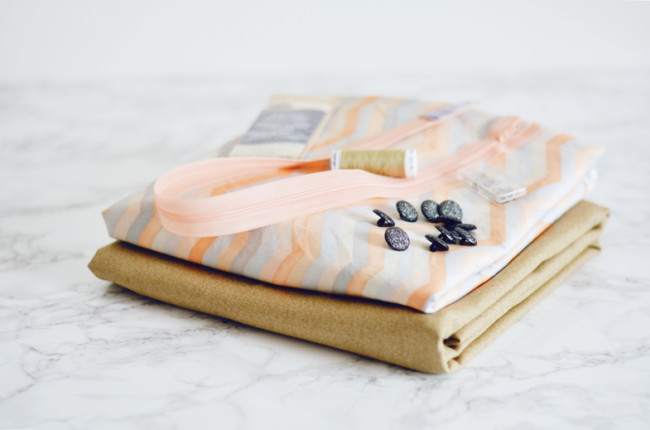
gather your supplies
- Main Fabric: For both versions, you’ll want a medium weight woven fabric like poplin, denim, twill, etc. You don’t want something too drapey, like a very fluid rayon or silk, because the style of the dress calls for a bit of structure in the fabric.
-
Lining Fabric: Both versions also call for lining fabric. Look for a lightweight fabric that will be comfortable against your skin. This can include lightweight polyester, bemberg rayon, acetate, and cotton lawn or voile.
-
Buttons: Version 1 requires ten 3/4″ buttons.
-
Zipper: Both versions require a 22″ regular coil zipper.
-
Hook & eye: Look for size 2 or 3.
-
Bias Tape (optional): A Hong Kong finish is a beautiful way to finish the raw edges of your seam allowances (more on that later!). It requires about four yards of 1/2″ single fold bias tape.
Choosing Your Fabric
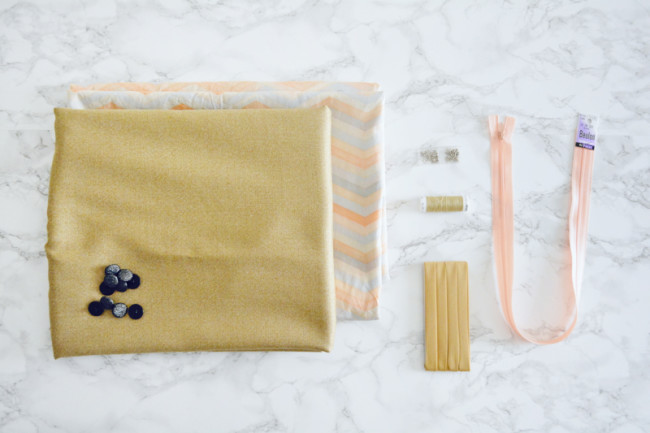
Phoebe is a structured shift with princess seams. Because princess seams skim and hug the figure, rather than hang from it, they will look smoother and more polished with a slightly more structured fabric. Something very fluid like rayon or silk might tend to droop a bit. Twill, lightweight corduroy, and velveteen would all be lovely options.
For the lining, look for something on the lighter side, as you don’t want to add too much bulk. It will be against your skin, so you want something smooth and non-irritating. And in this case, drape is ok! Bemberg rayon is one of my favorites, and it has a very cool feel. You can also use a polyester or acetate lining. If you’re a newbie, you might want to find a cotton lawn or voile for the lining, as it will be a little easier to work with than some of the more slippery options.
Remember too that linings don’t have to be solid, as long as your main fabric is opaque or dark enough. One of my favorite things to do when making a solid garment is to use a fun print for the lining – it’s like your clothes have secrets.
For both fabrics, the yardage requirements can be found on the back of your pattern envelope, and by clicking on the “Supplies” tab on the Phoebe page in the Colette Patterns online store.
Make sure you are reading the yardage quantity for the width of fabric you are buying. The yardage amounts are for non-directional fabrics, so if you have a directional print or a napped fabric like corduroy, you’ll want to buy a little extra (like ¼ -½ yard) to accommodate a slightly different cutting layout. You’ll also need extra fabric if you’re going to be matching plaid/stripes across seams.
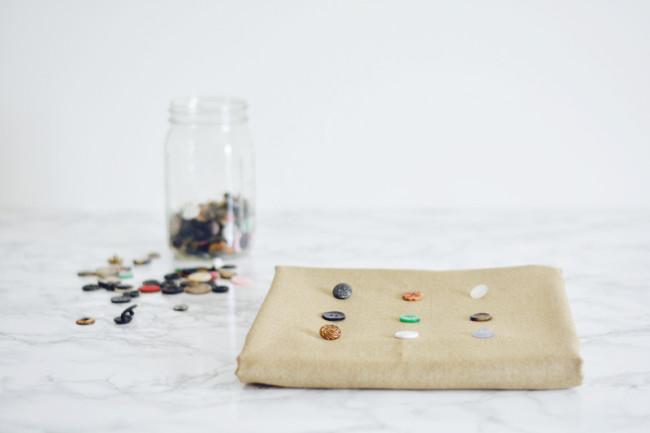
When buying buttons, remember – as long as they’re the right size, you can always change them later. If you can’t find buttons you like, or if you want your buttons to match perfectly, make your own with a button cover kit.
Some Fabric Options
Since one of my most practiced skills is window shopping for fabrics online, here are a few main/lining fabric pairings that could make nice Phoebes.
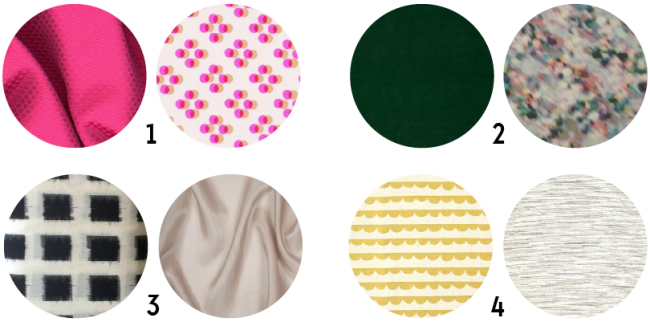
1.
Dove Jacquard Pink Dot from Harts Fabric
Cotton + Steel Picnic Dot Lawn from Harts Fabric
2.
Robert Kaufman Lush Velveteen in Forest from Fabricworm
Japanese Cotton Lawn from Hellgate Fabrics
3.
Double Black Ikat from Craft South
Moonstruck Viscose Lining from Mood Fabrics
4.
Metallic Gold Ellen Baker Canvas from Miss Matatabi
Veronica Voile in Stone from Superbuzzy
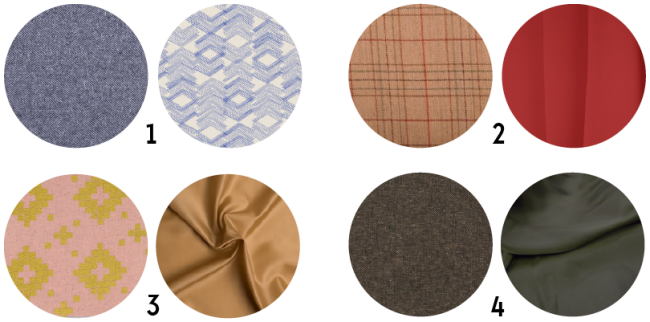
1.
Herringbone Wool from Mood Fabrics
Limestone Feel Voile in Indigo from Hawthorne Threads
2.
Plaid Wool Suiting from Mood Fabrics
Red Bemberg Rayon from Britex Fabrics
3.
Cotton + Steel Mesa Canvastile in Rose from Superbuzzy
Antique Gold Polyester Lining from Mood Fabrics
4.
Essex Yarn Dyed Linen/Cotton in Espresso from Modern Domestic
Chocolate Bemberg Rayon from Vogue Fabrics
Note: If you do choose a very contrasting lining, be aware that it may peek out from time to time at the armscye.
Gather Your Tools
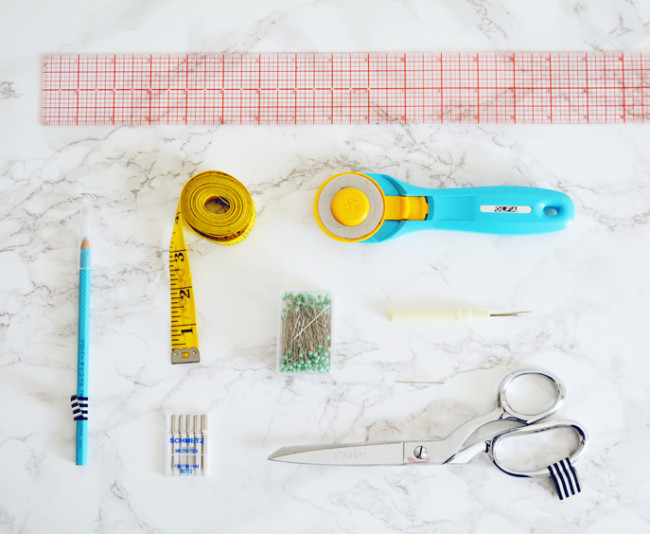
- Fabric shears: A very important tool! Be sure they’re sharp, and never use them on anything other than fabric.
Straight pins: More pins is more control. Glass or metal headed pins are convenient because you can press over them.
Tape measure: For taking accurate body measurements.
Water soluble marking tools: We’ll need them for transferring darts, buttonholes, and anything else we need noted on our fabric.
Seam ripper: Everyone makes mistakes.
Rotary cutter/mat: If you’re comfortable with a rotary cutter, they can make cutting out your Phoebe a bit faster.
Hand sewing needle: For attaching the buttons and hook/eye.
Machine needles: Size 80, universal or microtex.
Optional: It’s not necessary, but it’s very helpful to have a water soluble basting agent when installing the zipper. Two of my favorites are Wonder Tape, which is a narrow double-sided tape, and a basting glue stick. Both are formulated to dissolve completely away in water.
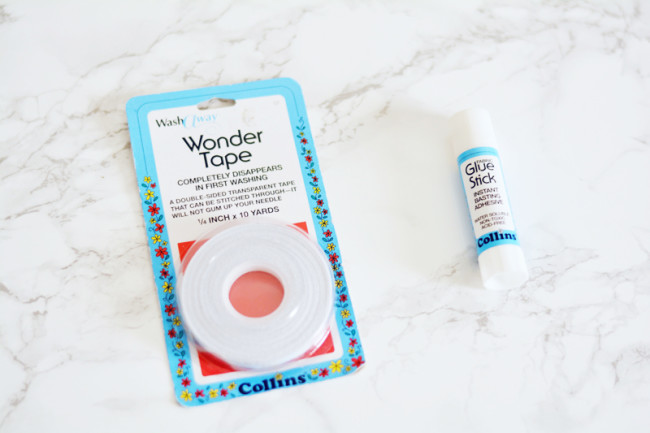
Equipment
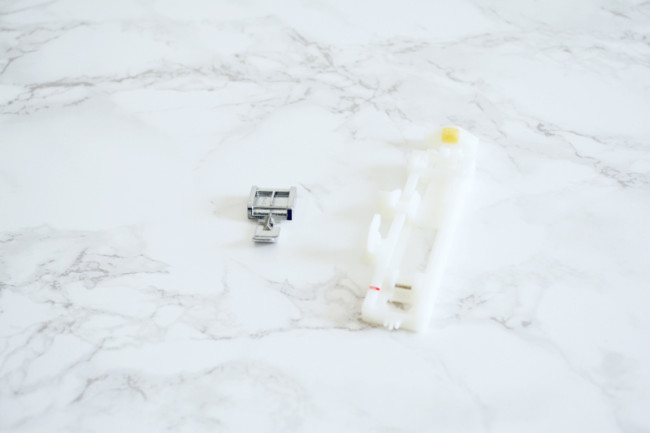
Both versions will require your sewing machine’s zipper foot (left). If you’re making Version 1, you’ll also need the buttonhole foot. The one pictured above is an automatic buttonhole foot. Yours might look a little different, especially if you have a multi-step buttonhole.
Pretreat your fabric
Before cutting, pretreat your fabric however you plan on caring for the actual garment. This is not something you want to skip, because there’s nothing worse than your fabric shrinking after you’ve made something.
If you’re using wool or silk, you can take it to the dry cleaner first. Most wools and silks can also be safely hand washed in tepid water with a delicate detergent. It’s always good to test wash a swatch first.
Next week, we’ll discuss several fit adjustments you can make to your pattern. If you have any questions about supplies, please comment below!



Comments
Love the fabric pairings! Thanks for showing so many great options, that is super helpful.
glad you like them!
“…use a fun print for the lining – it’s like your clothes have secrets.” I love that.
haha…it makes getting dressed a lot more fun!
I am so excited to be joining this sew along, my first for a few years. I have a lovely mini corduroy, just the lovelyest colours too.
pooh sounds cute!
Looking forward to this sewalong!
Is this a pattern that could be made from ponte fabric? or is even a sturdy knit not advised?
Hi Jen! If you make it from a ponte, there will be a little bit of experimentation involved. Since it’s designed for a non-stretch woven, a fabric with a little stretch is going to fit bigger than the pattern is designed. However, if you’re willing to pin and fit as you go, and take in as necessary, I think you could do it!
I am so excited to be in this sew-along! This is my first one! I’m going out to buy my fabric and supplies tomorrow. Can’t wait!
Could you please advise me – I am never certain if I should buy a pattern based on my actual body measurements eg bust 35in or a pattern based on the finished measurements?
The numbers in the size chart list your actual body measurements. So, for instance, a bust of 35″ would be a size 4. The finished garment measurements list the dimensions of the finished garments. For a non stretch woven fabric garment, the finished garment measurements should always be bigger than the body measurements, otherwise it would be very uncomfortable! For instance, size 4 has a finished bust of 36″. This means that there is 1″ of fitting space (aka ease) at the bust. This is a fairly snug fit.
So generally, you’d choose your size based on the size chart (body measurements), and then check out the finished garment measurements just to get an idea of how much ease is built into the pattern.
Like Jen, I am wondering about using ponte. I appreciate a bit of give in my clothes!
Hi Kathy! If you make it from a ponte, there will be a little bit of experimentation involved. Since it’s designed for a non-stretch woven, a fabric with a little stretch is going to fit bigger than the pattern is designed. However, if you’re willing to pin and fit as you go, and take in as necessary, I think you could do it!
Thanks for the reply Devon – now the difficult decision!
I like combo 4 (Essex Yarn Dyed Linen/Cotton in Espresso from Modern Domestic
Chocolate Bemberg Rayon from Vogue Fabrics) but am wondering if a cotton lawn or voile would work instead of the rayon based on your advise to newbies – which I am.
Yes! If a cotton lawn or voile would definitely be easier than a rayon, and would make a great lining.
Thanks for the fabric suggestions! Decisions, Decisions…..A wool version would be wonderful! So would one in denim!
both would be dreamy!
I have a Moda cotton that is sort of quilting weight and certainly not drapey. But it’s also not anywhere near a corduroy or velveteen or wool. Do you think if I underlined it in addition to lining it, that would give it enough body? I’d be inclined to underline the skirt as well, I think. (If you think it still wouldn’t have enough body, I guess I can visit my stash and reconsider!)
Thanks so much. I’m an experienced sewist, but I’m eager to learn about full bust adjustments for this pattern..
Quilting weight cotton would be fine without any additional underlining! It’s technically a medium weight fabric so it totally fits the bill.
Good to know! Whenever I see “medium weight” as a recommended fabric, I sometimes err on the side of too heavy. You’ve just helped me with other projects, too!
will a jacquard fabric work? Looking to buy online. Donna
Hi Donna! It depends on the weight of the jacquard. As long as it is appropriate for garments and not, for instance, upholstery fabric, then it should work.
I’ve chosen a dark denim. Wouldn’t the a full weight denim be too heavy with a lining?
Also, Quilting Cotton or Kona cotton would also be good choices for a version of the dress? I’m going to have to try a muslin since I just lost 20lbs. I might try a summer version….
Barb
Hi Barb! It would definitely depend on the denim. Something for heavy jeans would be too heavy, but there are also lighter weight denims that would be fine. Think the weight of denim that would be a denim shirt, up to a tiny bit heavier than that. Quilt weight and Kona cottons would definitely work!
If I am using a light weight corduroy for my dress, what would the best fabric for the lining be? I like the idea of rayon inside the corduroy, but I am a very novice clothing sewer. This will be my first garment with a lining and a zipper. Will rayon be too difficult? Also, what does it mean when it asks for a regular coil zipper? Does it say this on the packageing?
Cotton lawn or voile will be the easiest lining fabrics to work with. Rayon is a lot more slippery and fluid, which makes it a bit more challenging.
Regular coil just means normal zipper, as opposed to an invisible zipper, which has a reversed coil. The coil is just another name for the teeth.
I was planning on underlining w/organza but only the bodice is lined. Is it OK to underline the bodice & not the skirt? Or do I underline it all & just improvise a skirt lining? PS. My fashion fabric is a cotton/spandex blend (97/3); about a 16 wale, I think.
Thx in adance for advice.
Hi Anna! Out of curiosity, why were you planning on underlining? Generally you’d only need to underline if your main fabric is sheer or see through, and if you’re using stretch corduroy (is that what you mean by 16 wale?) then you don’t need to underline.
Thank you for the advice. I’ll set the organza aside and use for another project.
btw: The 16 wale reference was to the size of the wales or vertical ridges of the corduroy.
Hi,
I love the look of version 2 with the buttons, but I don’t have experience sewing button holes. Would it work okay if made version 2 but didn’t make the button holes and just sewed the buttons through both layers so the buttons would just be decorative?
Sure, you could do that! Since there is a zipper in the back you don’t need the function of the buttons to get in or out of the dress so that’s a totally viable option! (also, we’ll be talking about how to do both a one step and multi step buttonhole and it hopefully won’t be too scary, so you can maybe give it a shot on the next one. :) )